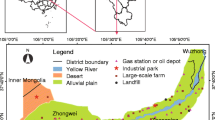Abstract
Interaction between vulnerability and contaminating charge was used in order to determine the groundwater contamination danger. The result of danger being adapted to the scale of impact on human or animal health and ecosystems is known as “risk”. Index and overlapping methodologies such as EPNNA, DRASTIC, SINTACS, GOD AVI, and Ekv were used and compared to evaluate vulnerability. Contaminating charge to the subsoil, which is generated from specific human activity, has four characteristics: kind of contaminant, means of disposal, intensity, and duration. Interaction among these characteristics obtains a Contaminating Charge Index. In the Bajo Cauca Antioqueño region, over 150,000 inhabitants require ground water for meeting their basic needs at home, for cattle breeding activities, and for irrigation. For this region, an assessment of the groundwater contamination of the free aquifer, as well as an estimation of its impact and the danger this contamination may pose to ecosystems or communities has been performed. Analysis of the interaction between vulnerability and threat allows for the creation of danger and risk maps.





Similar content being viewed by others
References
Auge M (2004) Aquifers vulnerability, concept and methods. Universidad de Buenos Aires, Buenos Aires
Báez A (2001) Validation vulnerablity maps in urban areas. I Workshop-seminar. Protection of aquifers before contamination: methodology. Web Physical publication. http://tierra.rediris.es/hidrored/ponencias/baez.html. Consulted on April 12th, 2012
Betancur T (2005) Current status and perspectives of hydrological reserch at Bajo Cauca antioqueño. Boletín de Ciencias de la Tierra No. 17, Universidad Nacional, Medellín, pp 97–108
Betancur T (2008) An approximation to knowledge of a tropical aquifer system. Study case: bajo cauca antioqueño. PhD thesis, Universidad de Antioquia
Dublin declaration (1992) Dublin declaration on water and sustainable development. Physical publication Web. http://www.wmo.int/pages/prog/hwrp/documents/espanol/icwedecs.html. Accessed 12 Apr 2012
Foster S, Hirata R (1987) Contamination of underground waters. An executive approach of the situation in Latin America and the Caribbean in relation to the supply of fresh water. CEPIS with WHO and la OPS, Lima, Perú
Foster S, Hirata R (1992) Strategies for the protection of underground waters (A guide for its implementation). CEPIS with WHO and the OPS, Lima, Perú
Foster S, Hirata R, Gomes D, D’Elia M, Paris M (2002) Protection to the quality of underground water. World Bank, Washington, D.C
Gaviria JI, Betancur T (2005) A characterization of contaminating charge to free aquifers of Bajo Cauca antioqueño. Manag Environ J 8(2):85–102
Green E, La Motte A, Cullinan K (2004) Ground-water vulnerability to nitrate contamination in the Mid-Atlantic region. USGS Fact Sheet FS 2004-3067. Physical Publication Web. http://pubs.usgs.gov/fs/2004/3067/. Consulted on April 12, 2012
Henry JG, Heinke GW (1994) Environmental engineering. Prentice Hall, México
Husam, M. B (2011) Mapping groundwater contamination risk using GIS and groundwater modelling. A case study from the Gaza Strip, Palestine http://link.springer.com/10.1007/s12517-010-0135-0
Lobo-Ferreira JP, Oliveira M (2004) Groundwater vulnerability assessment in portugal. Int Geophys 43(4):541–550
Lobo-Ferreira J (1997) GIS and Mathematical Modeling for the Assessment of Vulnerability and Geographical Zoning for Groundwater Management and Protection. NATO Advanced Research Workshop. Environment Contamination and Remediation Practices at Former and Present Military Bases, October 12–17, 1997, Vilnius, Lithuania
Massone H, Martínez D (2007) Management Process of the Impact and Risk of Contamination of Aquifers. Its Application in the Bonaerense Southeast. IV Argentinean Congress of Hydrology and II Latin American Spanish Seminar on Current Topics of Ground Hydrology
Massone H, Sagua M (2005) Integration of Social Vulnerability in the Assessment of Aquifers Contamination Risk. IV Argentinean Congress of Hydrology and II Latin American Spanish Seminar on Current Topics of Ground Hydrology. Minutes, 201–210. Rio Cuarto, Córdoba. ISBN 950-665-347-X
Mejía O, Betancur T, Londoño L (2007) Application of Geo-statistical techniques in hydrology of Bajo Cauca antioqueño. DYNA J 74(152):137–150
Nguyet V, Goldscheider N (2006) A simplified methodology for mapping groundwater vulnerability and contamination risk, and its first application in a tropical karst area, Vietnam. Hydrogeol J 14:1666–1675
Pérez R, Pacheco J (2004) Vulnerability of groundwater to contamination of nitrates in the state of Yucatán, Research article. Engineering 8–1(2004):33–44
Rueda M, Ángel J (2004) Preliminary Methodological Proposal to Grade the Contaminating Charge to Sub-Soil in a Free Aquifer. IV Workshop-Seminar: Protection of Aquifers before Contamination: Protection of Water Quality. Lima, Perú
Rueda M, Betancur T (2006) Evaluation of gound water vulnerability in Bajo Cauca antioqueño. Adv Hydraul Res J (13):71–88
Rupert MG (1999) Improvements to the DRASTRIC groundwater vulnerability mapping method. National water-quality assessment program—NAWQA. USGS Fact Sheet FS-066-99. Web Physical publication. http://id.water.usgs.gov/PDF/factsheet/DRASTIC.pdf. Accessed 12 Apr 2012
Universidad de Antioquia (2007) Hydro-chemical and Isotopic Techniques for the Assessment of Hydrological Processes in the Wetlands of Bajo Cauca antioqueño. Report of advances of contract 14031 with Atomic Energy International Entity
Vrba and Zaporozec (1994) Guidebook on mapping groundwater vulnerability international association of Hydro Geologists, vol. 16. ISBN:3-922705-97-9
Author information
Authors and Affiliations
Corresponding author
Rights and permissions
About this article
Cite this article
Betancur, T., Palacio, C., Gaviria, J.I. et al. Methodological proposal to assess groundwater contamination danger: study case of Bajo Cauca aquifer (Colombia). Environ Earth Sci 70, 315–328 (2013). https://doi.org/10.1007/s12665-012-2129-6
Received:
Accepted:
Published:
Issue Date:
DOI: https://doi.org/10.1007/s12665-012-2129-6




